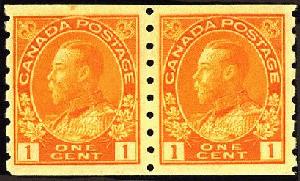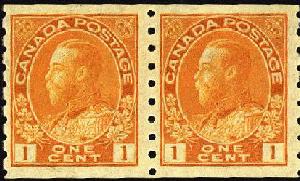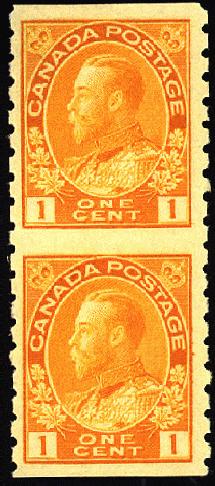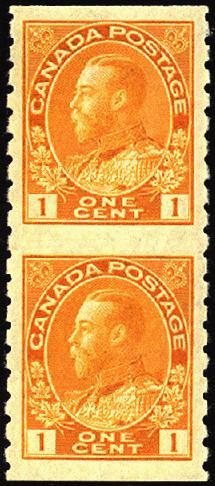
Die I

Die II
The one-cent yellow coil was issued in rolls of 500, imperforate horizontally and perforated 8 vertically. As with the Post Office sheet stamps, this version of the stamp appeared in both Wet and Dry printings. Five Plates, 10 to 14 were used for the Retouched Die I printings, all of the 400 subject Type F format, and of which both Wet and Dry printings exist. Only Plates 15 to 17, also Type F, were used from Die II. It is possible that Plate 15 was not in fact used. All printings of the Die II were by the Dry method. (See Summary for details on the plates.)
 Die I |
 Die II |
The date of issue is not confirmed, but the earliest known cancellation is from November 1922.
The total number of rolls printed is given as 51,400 Precancelled, and 263,000 Not precancelled. (Rolls of 500 stamps)
The previous coil format was also released in sheet form, which of course appeared with the vertical perforation of 8, and imperforate horizontally. Known in Wet printed form from Plates 11 and 12, (Die I), and Dry printed from Plates 16 and 17 (Die II).
 Part Perforate Die I |
 Part Perforate Die II |
Unfortunately, the Die I Wet printed version lends itself to faking, with stamps from the imperforate sheets having a Perforation applied vertically. They can be detected, however, as the imperforates were printed from Plates 179 and 180, and these stamps are of one of the sub-types that exhibit the lower left frame junction line broken below the top of the lower left spandrel. The genuine stamp has no break. Even more distinctive in the case of the genuine stamps from Plate 12 is the broken line in the left numeral box of the genuine stamp, whereas with the imperforates this line is unbroken.
The dates of issue are uncertain, as some stamps were released to individuals as a favour, and unofficially. The later Die II printings were released partly to pacify angry collectors, as news of the "favour" releases became known.
Numbers issued have caused some difference of opinion between the various authorities. Boggs quotes 22 sheets, or 2,200 stamps. Reiche stated that only 9 sheets had been released. Concensus of opinion, with a later input from the Acting Deputy Postmaster General, suggests Boggs' figure was correct.
Type B on Plates 11 and 12, and Type D on Plates 13 and 14. (See Lathework for an explantion of types.)
Updated: 5 Oct 97